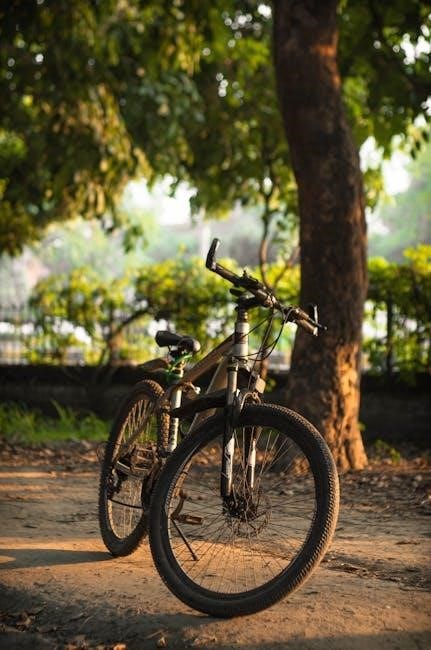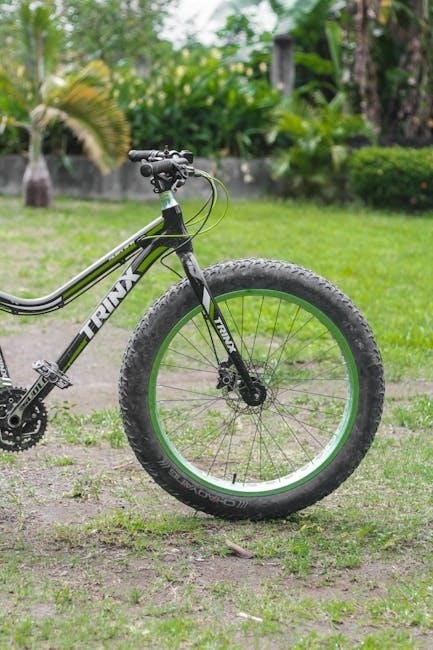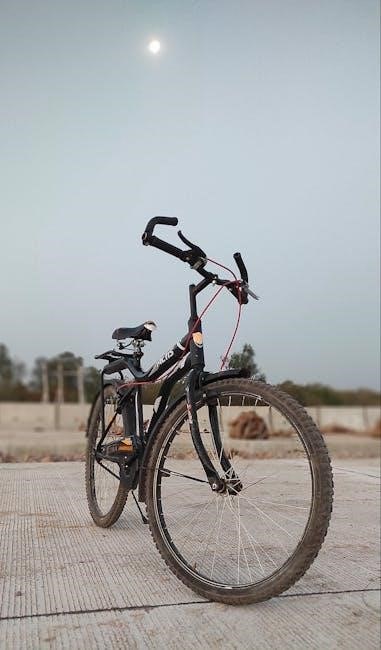Dirt bike tire sizes are crucial for optimal performance, handling, and safety. Understanding the numbers ensures proper fitment, balancing width, aspect ratio, and rim diameter for varied terrains and riding styles.

1.1 Importance of Proper Tire Size for Performance and Safety
Proper dirt bike tire size is crucial for optimal performance and safety. Incorrect sizes can lead to poor handling, reduced traction, and increased risk of tire failure. Mismatched tires may affect stability, especially at high speeds or on uneven terrain, potentially causing loss of control. Additionally, wrong tire sizes can strain the bike’s suspension and other components, leading to mechanical issues. The right tire size ensures better acceleration, braking, and maneuverability, making the ride safer and more enjoyable. Always prioritize correct fitment for enhanced durability and rider confidence.
1.2 Brief Overview of Dirt Bike Tire Sizing System
Dirt bike tire sizes are typically denoted by a code on the sidewall, such as 120/100-18. The first number represents the tire width in millimeters, the second is the aspect ratio, and the third indicates the rim diameter in inches. This system standardizes measurements to ensure compatibility and proper fitment. Understanding this code is essential for selecting tires that match your bike’s specifications, ensuring optimal performance and safety. Always refer to the manufacturer’s guidelines for accurate interpretation and application of this sizing system.

Understanding Dirt Bike Tire Size Codes
The dirt bike tire size code, such as 120/100-18, provides essential information about tire dimensions. Breaking down these numbers helps riders choose the right tires for their bike easily.
2.1 Breaking Down the Tire Size Designation
A dirt bike tire size designation, like 120/100-18, is divided into three key parts: the tire width, aspect ratio, and rim diameter. The first number, such as 120 or 100, represents the tire’s width in millimeters. The second number, following the slash, indicates the aspect ratio, which is the percentage of the width that makes up the tire’s height. Lastly, the number after the hyphen, like 18, denotes the rim diameter in inches. This standardized code helps riders match tires to their bike’s specifications and riding needs. Understanding these components ensures proper fitment and optimal performance on various terrains. Always refer to the manufacturer’s guidelines to avoid sizing errors. This breakdown is essential for selecting tires that enhance both safety and handling. By decoding these numbers, riders can make informed decisions tailored to their specific requirements, whether for motocross or trail biking. Proper tire size designation interpretation is the first step in achieving a superior riding experience.
2.2 Key Components: Width, Aspect Ratio, and Rim Diameter
The width, expressed in millimeters, determines the tire’s contact patch and traction. The aspect ratio, as a percentage of width, affects sidewall stiffness and ride comfort. The rim diameter in inches ensures compatibility with the bike’s wheels. Together, these components influence handling, stability, and performance. A wider tire offers more grip but may sacrifice agility, while a narrower tire improves maneuverability. Proper alignment of these measurements with the bike’s specifications is vital for optimal functionality and safety. Understanding these elements helps riders tailor their tire choice to specific riding conditions and preferences. This balance ensures enhanced control and durability, making it critical for both casual and competitive riders.
Standard Dirt Bike Tire Sizes
Standard dirt bike tires vary, with front sizes typically 21″ and rear sizes 18-19″ for motocross, while trail bikes often use 18″ rear tires for versatility.
3.1 Common Front and Rear Tire Sizes
Standard dirt bike tire sizes vary by bike type and use. Front tires typically range from 80/100-21 to 90/90-21, while rear tires are often 110/90-18 to 120/80-19. Motocross bikes commonly use 19″ rear tires for better traction, whereas trail bikes may opt for 18″ rear tires for versatility. These sizes ensure compatibility with various terrains, from tight trails to open tracks, providing optimal balance and control for different riding styles and conditions.
3.2 Variations for Motocross vs. Trail Bikes
Motocross bikes often use larger rear tires, like 120/80-19, for maximum traction on soft tracks, while trail bikes may prefer 110/100-18 for durability on varied terrain. Front tires for motocross typically range from 80/100-21 to 90/90-21, whereas trail bikes might use slightly narrower sizes for maneuverability. These variations ensure each bike type excels in its intended environment, balancing speed, stability, and control.
Factors Influencing Tire Size Selection
Terrain type, riding style, bike type, and intended use significantly influence tire size selection, ensuring optimal performance and safety in various conditions.
4.1 Terrain and Riding Style
Terrain and riding style play a vital role in selecting dirt bike tires. For motocross, wider tires with aggressive tread ensure stability and traction on rough tracks. Trail bikes benefit from narrower tires with versatile tread patterns, offering balance on mixed terrain. Riding style also matters—aggressive riders may prefer tires with reinforced sidewalls and deeper treads for durability. Matching tire size to terrain ensures better control, grip, and overall performance, enhancing the riding experience.

4.2 Bike Type and Intended Use
Bike type and intended use significantly influence tire size selection. Motocross bikes require tires with specific tread patterns for track grip, while trail bikes need versatility for varying terrain. The intended use—racing, casual riding, or endurance—dictates tire width, aspect ratio, and durability. Ensuring the tire matches the bike’s design and purpose optimizes performance, safety, and rider comfort, making it essential to align tire size with the bike’s specific application and the rider’s goals.

How to Choose the Right Tire Size
Selecting the right dirt bike tire size involves measuring current tires, using size charts, and considering rider weight. This ensures optimal performance and safety.
5.1 Measuring Your Current Tires
To measure your dirt bike tires, start by locating the sidewall markings. The numbers represent width, aspect ratio, and rim diameter. Measure the widest part of the tire for width, and use a ruler to check the sidewall for aspect ratio. Ensure the tire is inflated to the recommended pressure for accuracy. Measure both front and rear tires, as sizes may differ. Accurate measurements ensure proper fitment, crucial for safety and performance. Always refer to your bike’s manual if the sidewall is worn or unclear.
5.2 Using a Dirt Bike Tire Size Chart
A dirt bike tire size chart is a valuable tool for selecting the right tires. It provides a comprehensive list of compatible sizes for your bike, ensuring proper fitment. The chart typically includes width, aspect ratio, and rim diameter, organized by bike model or year. By referencing the chart, you can quickly identify standard sizes, such as 21″ front and 19″ rear for motocross bikes, or 18″ rear for trail bikes. This ensures optimal performance, safety, and compatibility with your bike’s specifications.
5.3 Considering Rider Weight and Load
Rider weight and load significantly impact tire performance. Heavier riders or those carrying additional weight require tires with sufficient width and durability to maintain stability and traction. Excess weight can cause tire burping or reduced grip, especially on wider tires. Ensuring the tire size matches the rider’s weight ensures optimal handling and safety. Always consider load capacity when selecting tires, as underestimating weight can compromise performance and durability, particularly on challenging terrains or high-speed rides.
Dirt Bike Tire Size Calculator
A dirt bike tire size calculator is an essential tool for finding the perfect fitment. It uses tire width, aspect ratio, and rim diameter to ensure optimal performance, safety, and durability.
6.1 How to Use Online Tools for Accurate Fit
Online tire size calculators simplify finding the right fit by inputting your bike’s make, model, and year. Enter the desired tire width, aspect ratio, and rim diameter to see compatible options. These tools cross-reference manufacturer specifications to ensure accuracy. They also account for load ratings and speed requirements, reducing guesswork. For precise results, measure your current tires or consult your bike’s manual. Using these tools ensures a safe and performance-enhancing fit tailored to your riding needs.
6.2 Interpreting Calculator Results
Understanding the results from a dirt bike tire size calculator is essential for making informed decisions. The calculator provides specific recommendations based on your bike’s make, model, and intended use. It lists compatible tire sizes, ensuring proper fitment and performance. Pay attention to load ratings and speed ratings to match your riding conditions. Always cross-reference the results with your bike’s manual or manufacturer specifications to ensure accuracy. This step guarantees a precise fit, enhancing both safety and performance.

Tire Size and Bike Handling
Tire size significantly impacts bike handling, with wider tires offering enhanced stability and traction. Narrower tires improve agility but may compromise grip on loose surfaces.

7.1 Effects of Tire Width on Stability and Traction
Tire width plays a critical role in stability and traction. Wider tires provide a larger contact patch, enhancing grip on loose surfaces and improving cornering stability. However, excessively wide tires can increase weight and affect agility, potentially compromising maneuverability in tight spaces. Narrower tires, while lighter and more agile, may sacrifice traction on soft or uneven terrain. Balancing width with riding conditions ensures optimal performance and control, making it essential to match tire width to the specific demands of the terrain and riding style.
7.2 Aspect Ratio and Its Impact on Performance
The aspect ratio significantly influences a dirt bike’s performance. A higher aspect ratio offers a taller tire profile, improving absorption of shocks and bumps, which is beneficial for rough terrains. Conversely, a lower aspect ratio results in a shorter, stiffer tire, enhancing responsiveness and stability at higher speeds. The right aspect ratio balances comfort and handling, ensuring optimal performance based on the rider’s preferences and the specific demands of motocross or trail riding.
Common Mistakes in Tire Size Selection
Common mistakes include oversizing or undersizing tires, which can compromise performance and safety. Ignoring aspect ratio and rim diameter often leads to poor handling and reduced traction.
8.1 Oversizing or Undersizing Tires
Oversizing or undersizing tires can lead to poor stability, reduced traction, and compromised handling. Oversized tires may cause loss of grip, while undersized tires can result in inadequate support and uneven wear. Both mistakes can affect bike performance, making it harder to control, especially on challenging terrains. Proper tire fitment is essential for safety and optimal performance, ensuring the bike handles as intended. Always refer to size charts and expert advice to avoid these common errors and maintain your bike’s responsiveness and stability.
8.2 Ignoring Aspect Ratio and Rim Diameter
Ignoring the aspect ratio and rim diameter can lead to improper tire fitment, affecting bike stability and performance. The aspect ratio determines sidewall height, impacting ride comfort and handling, while rim diameter must match the wheel size for optimal tire functionality. Misaligning these components can cause vibrations, uneven wear, and safety risks. Always ensure these measurements align with your bike’s specifications to maintain balance, control, and durability, especially when tackling rough or technical terrains where precise handling is crucial for rider safety and confidence.

Maintenance Tips for Dirt Bike Tires
Regularly clean tires, inspect for punctures, and ensure proper pressure. Check tread wear and store bikes upright to prevent flat spots, ensuring optimal performance and longevity.
9.1 Checking Tire Pressure

Regularly checking tire pressure is essential for optimal performance and safety. Use a pressure gauge to ensure tires match the manufacturer’s recommended levels, as specified in your bike’s manual. Proper pressure maintains stability, traction, and handling, while under-inflation can lead to poor performance and increased risk of punctures. Check pressure when tires are cold, as riding warms them up and affects readings. Adjusting pressure based on terrain and load ensures consistent grip and control, enhancing both comfort and durability of your dirt bike tires.
9.2 Monitoring Tread Wear
Monitoring tread wear is vital for maintaining dirt bike performance and safety. Inspect tires regularly for uneven wear, bald spots, or damage. Use a tread depth gauge to measure wear, replacing tires when tread reaches minimum levels. Uneven wear may indicate misalignment or improper inflation. Addressing wear early prevents traction loss and reduces the risk of punctures. Replacing worn tires ensures consistent grip, handling, and control, keeping your dirt bike performing at its best on the trail or track.
Choosing the right dirt bike tire size enhances performance, safety, and riding experience. Proper fitment, regular maintenance, and monitoring tread wear ensure optimal handling and durability on various terrains.
10.1 Recap of Key Points
Understanding dirt bike tire sizes is essential for performance, safety, and handling. Proper fitment involves width, aspect ratio, and rim diameter, tailored to terrain and bike type. Regular maintenance, like checking tire pressure and monitoring tread wear, ensures durability. Using size charts and calculators helps in selecting the right tires. Avoid oversizing or undersizing, as it affects stability and traction. Always consider rider weight and load for optimal performance. By following these guidelines, riders can enhance their overall experience and safety on the trail or track.
10.2 Final Tips for Optimal Tire Performance
Regularly check tire pressure and tread wear for optimal performance. Ensure tires are compatible with your bike’s rim diameter and aspect ratio. Avoid oversizing or undersizing, as it affects stability. Use a dirt bike tire size calculator for precise fitment. Maintain proper tire pressure for varied loads and terrains. Replace worn-out tires promptly to prevent performance issues. Always consider rider weight and bike type when selecting tires for enhanced safety and control on the trail or track.



0 Comments